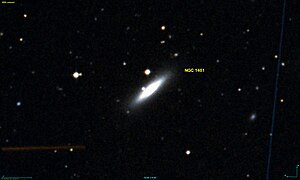NGC 1401
| Galaxy NGC 1401 |
|
|---|---|

|
|
| AladinLite | |
| Constellation | Eridanus |
|
Position equinox : J2000.0 , epoch : J2000.0 |
|
| Right ascension | 03 h 39 m 21.8 s |
| declination | -22 ° 43 ′ 29 ″ |
| Appearance | |
| Morphological type | SB (s) 0 ^ 0 ^: / sp |
| Brightness (visual) | 12.1 mag |
| Brightness (B-band) | 13.1 mag |
| Angular expansion | 2.40 x 0.6 |
| Position angle | 130 ° |
| Surface brightness | 12.3 mag / arcmin² |
| Physical data | |
| Affiliation |
Eridanus cluster SSRS group 72 LGG 97 |
| Redshift | 0.004987 ± 0.000077 |
| Radial velocity | 1495 ± 23 km / s |
|
Stroke distance v rad / H 0 |
(63 ± 5) x 10 6 ly (19.2 ± 1.4) Mpc |
| history | |
| discovery | Wilhelm Herschel |
| Discovery date | December 9, 1784 |
| Catalog names | |
| NGC 1401 • PGC 013457 • ESO 033711-2253.1 • MCG -04-09-042 • 2MASX J03392185-2243289 • SGC 033711-2253.1 • GC 749 • H III 247 • h 2568 • GALEX ASC J033921.81-224329.2 • LDCE 0251 NED031 | |
NGC 1401 is a lenticular galaxy of the Hubble type SB0 in the constellation Eridanus in the southern sky . It is an estimated 63 million light years away from the Milky Way and about 45,000 light years in diameter .
In the same area of the sky are the galaxies NGC 1395 , NGC 1403 , NGC 1415 , NGC 1416 , among others .
The object was by astronomer William Herschel on December 9, 1784 using a 18.7-inch - telescope discovered.
